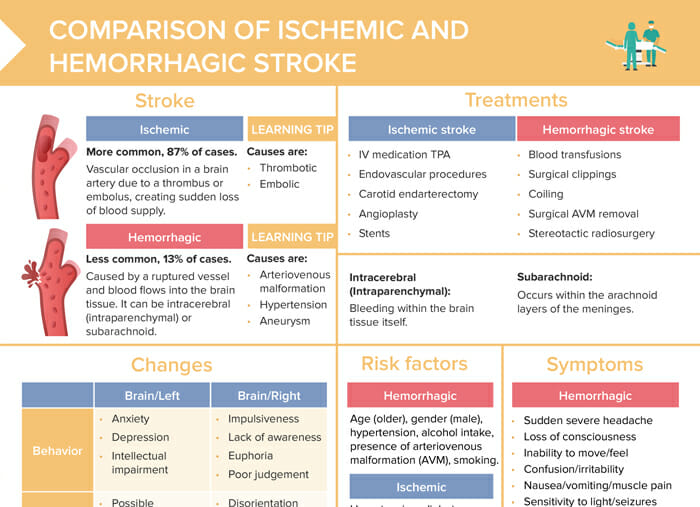#1 Look at the question stem
“An adult child of an older client tells the nurse that the parent is displaying new symptoms of disorientation and slurred speech. Which actions are nursing priority? Select all that apply.”
Gather the information
- Adult/parent is reporting → we can trust the report
- Symptoms have just started: change in older client’s status → high alert
Evaluate any assessments in the question
Orientation and speech are examples of things we can assess to see if the client’s status is normal or abnormal. The client is disoriented ➜ not normal; and their speech is slurred ➜ also not normal.
Recognize cues
We are looking at a new onset of disorientation and slurred speech in an older client.
Formulate your hypothesis
Based on the understanding of the question stem, ask yourself: What is your hypothesis about what could be wrong with this client?
The cues we recognize raise the suspicion that this client might be experiencing a stroke. This will be your basis for evaluating all of the answer options.
#2 Put the question – and each answer choice – into your own words
Rewording will help you to not miss anything in the question and ensure you have understood it fully: “I have an adult child of an older client telling me the client is displaying abnormal behaviors or assessment. So, what is my priority now?”
- What is my hypothesis based on the behaviors/assessments?
- What does that mean I should prioritize doing as the nurse in this situation?
#3 Go through the answer choices
Since this is a “Select All that Apply”- question, any number between 1 and all of the choices could be correct.
Tip: Don’t let yourself be fooled by considerations such as “This looks like I should select more” or “I think I have selected too many” – correct answers could be one, two, three, four, or all of them.
Tip: Go through each Select All that Apply answer choices as if they were all separate questions. Look at each one of them individually.
Tip: When looking at each of the answer options, always keep in mind your hypothesis about the scenario that you formed based on the cues in the question stem.
Utilize note-taking
Use a scratch paper to put down notes for each answer option.
“A. Prepare client for a CT.”
This is a correct answer.
The cues of disorientation and slurred speech in combination with the client’s age are classic symptoms of a stroke. This makes a CT scan a priority for this client.
“B. Contact the lab for STAT blood tests.”
This is a correct answer.
An imbalance in electrolytes could be a possible cause for the client’s symptoms. Therefore, checking for this as a potential cause is a priority.
“C. Review all the client’s medications.”
This is an incorrect answer.
While checking the client’s medications sounds like a reasonable thing to do, their symptoms being new makes their medications an unlikely cause. So, while the medications definitely will be looked at, this is not our priority until other priorities are completed.
“D. Listen to the client’s lung sounds.”
This is an incorrect answer.
While all of our nursing clients are assessed, the important hypothesis in this question is that the client might be having a stroke. In this context, lung sounds are not a priority for the client’’s particular problem and assessing them is not a priority. It will not keep this client the safest in this scenario.
“E. Establish intravenous access.”
This is a correct answer.
For this client, the suspicion based on the cues is that they might be having a stroke. In this case, this client is likely going to need a higher level of care, so ensuring they have a good and patent IV access is a priority in this scenario.
#4 Recap
Go through your answer choices and decisions on each of the options and go through your reasoning again – do your choices make sense to you? Again, look at each answer option independently of the others in an SATA question.
You might want to go through all the ones you marked as correct first, and then go through the ones you marked as incorrect and reassure your reasoning for each.

